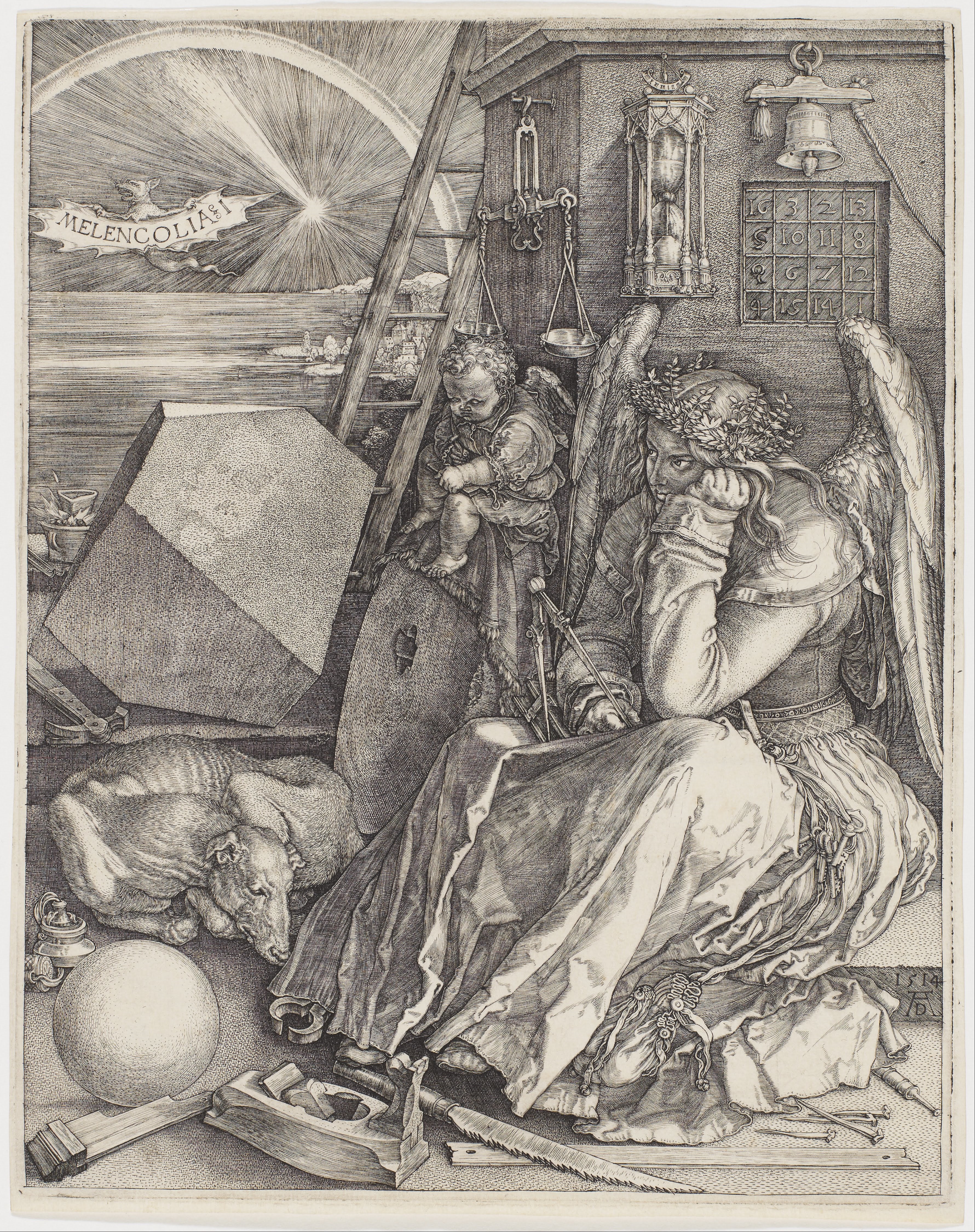'Melencholia I', a 1514 engraving by German master Albrecht Dürer, remains one of the most recognisable portrayals of depression throughout art history. We look back to the Renaissance concept of Humorism and to creativity as therapy, in order to find the light in the darkness. In tribute to this sombre classic, we are also presenting our very own pen and ink reproduction drawn by Rachel, now available to purchase as an art print from the Haus gallery.
In Renaissance philosophy, it was thought that the human condition could be understood further by looking at the fluids contained within the body; four fluids responsible for four temperaments, a concept in medieval philosophy that was known as ‘Humorism’.
Hippocrates, the ancient Greek physician cited as the ‘father of medicine’, suggested that the human body contained four distinct and vital bodily fluids that affected personality traits and behaviours. In order for full health to be maintained, these needed to be kept in harmonious balance, four liquid quarters divided into Blood, Phlegm, Yellow Bile and Black Bile.
Along with the four elements of earth, fire, air and water and the four seasons of spring, summer, autumn and winter, these fluids were attributed with certain temperaments believed to make up what was considered to be our human nature.

16th-century German illustration of the four humors.
Blood was associated with a sanguine nature (being enthusiastic, active and social), spring and air. Phlegm with a phelgmatic nature (showing a level of reservation, caution and constraint), winter and water. Yellow Bile with a choleric nature (ambitious and decisive though short-tempered), summer and fire, and finally Black Bile, associated with a melancholy nature, autumn and earth, the word melancholy itself deriving from the Greek for ‘black bile’.
In Renaissance thought, black bile was the least desirable of the four humors, as though often linked with creative genius, it was also thought to lead to insanity, the imagination of the artist being both gift and curse. Melancholy was often seen as a symbol of intellect, seriousness, nobility and emotional superiority, and whilst undesirable for the afflicted, it was also seen as a Romantic quality that many sought to capture in art and literature of the time.
16th century German master of engraving Albrecht Dürer created perhaps the most well known personification of melancholy in the 1514 engraving, ‘Melencholia I’, thought to be a spiritual self portrait of the artist himself and his own existential struggles with perfectionism and the perils of the creative journey.

Melencholia I - (Engraving) 1514 - Albrecht Dürer
In Dürer’s gothic masterpiece, a winged woman sits with furrowed brow and distant gaze, holding calipers in one hand, her head in the other, a whole host of symbols strewn around her, symbols that have been subject to scrutiny for years. Many are associated with geometry and measurement, tools of alchemy and astrology in fields of knowledge that Dürer studied obsessively in his quest to understand and portray beauty. She looks away, a sunken figure paralysed by her own self-doubt, laden with depression, an impotent angel. The ladder in the distance perhaps represents what she could climb if only she were able to lift herself out of the doldrums, to ascend to a higher spiritual realm of enlightenment. A string of keys are tied to her belt, perhaps representing opportunities to open doors that are currently locked, she has wings but doesn't have the strength to soar.
The 'I' following 'Melencholia' written on the scroll exhibited by a bat-like creature in the background also remains a mystery. Some think Dürer planned to draw three more engravings, this being the first of the four humors, others think it is an alchemical reference to Nigredo or blackness, the first stage of a magnum opus meaning decomposition. In analytical psychology, the term Nigredo became a metaphor for "the dark night of the soul", when an individual confronts the shadow within, certainly appropriate for our sullen angel in question.
It's ironic if not ultimately optimistic that in Dürer's self-reflective scene, tinged with a sepia sadness and heavy despair, that he created an enduring piece of art that many find inspiration and solace in to this day. Its resonance acts as a reminder of how important the very act of creating art is, regardless of the outcome. I have this framed on my window sill just above my desk, in fact, acting as both friend and muse, for those moments when melancholy inevitably blooms and feelings of 'Weltschmerz' threaten to overwhelm.
Along with, or despite of, the discarded tools at her feet, Dürer's act of creation is a tool in and of itself, a therapeutic tool to express the more malevolent feelings that we all experience from time to time; a metaphorical sword or shield for those creeping feelings of existential malaise and fear that hinder us from even trying, pushing us to retreat into the shadows from whence they came.

'Melancholia' (reproduction in pen and ink) 2023 - Rachel Anna Davies
In a time when both our individual and collective mental health is struggling and bile is rising both yellow and black, may we look upon Dürer's 'Melencholia I' not with loneliness or anxiety, but in awe, to see how beautiful and powerful those morose feelings can be when channelled into something meaningful and magnificent. Truly alchemy at work.

